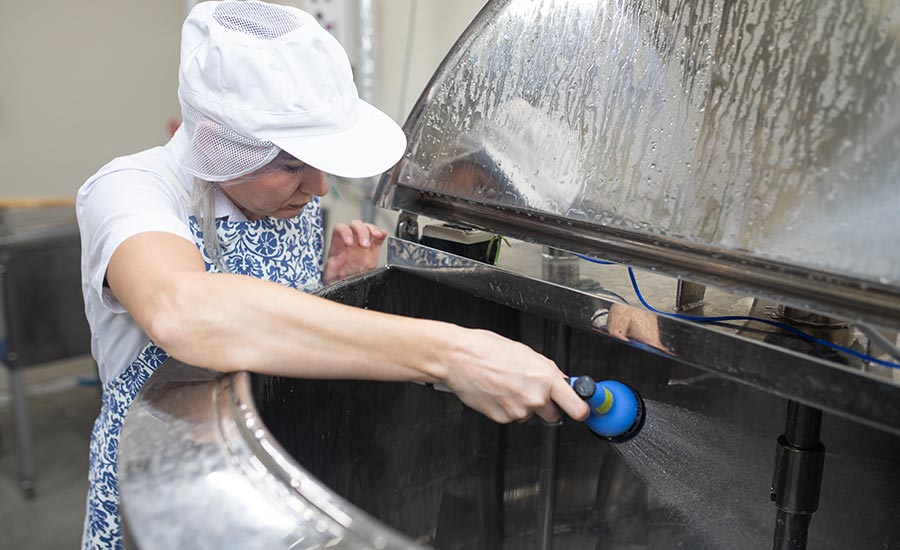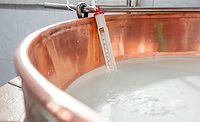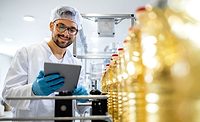The basics of cleaning and sanitation in food plants
Understanding the difference between cleaning and sanitizing is critical

A comprehensive cleaning and sanitation program is necessary to prevent contamination, control allergens and meet regulatory requirements.
Photo courtesy of Getty Images
The USDA’s HACCP regulation puts sanitation—cleaning and sanitizing—in its proper perspective:
Sanitation maintains or restores a state of cleanliness and promotes hygiene for prevention of foodborne illness.
It is an essential prerequisite program for food safety. The Preventive Controls Regulation for Human Food found in 21 CFR Part 117 further underscores the importance of this element. Preventive controls are defined as:
“…those risk-based, reasonably appropriate procedures, practices and processes that a person knowledgeable about the safe manufacturing, processing, packing or holding of food would employ to significantly minimize or prevent the hazards identified under the hazard analysis that are consistent with the current scientific understanding of safe food manufacturing, processing, packing or holding at the time of the analysis.”
The regulation establishes the following preventive controls:
- Process
- Allergen
- Sanitation
- Supply Chain
- Recall
- Other
21 CFR Part 117.135 (c) 3 specifically addresses sanitation preventive controls and may be seen below:
(3) Sanitation controls. Sanitation controls include procedures, practices and processes to ensure that the facility is maintained in a sanitary condition adequate to significantly minimize or prevent hazards such as environmental pathogens, biological hazards due to employee handling, and food allergen hazards. Sanitation controls must include, as appropriate to the facility and the food, procedures, practices and processes for the:
(i) Cleanliness of food-contact surfaces, including food-contact surfaces of utensils and equipment;
(ii) Prevention of allergen cross-contact and cross-contamination from insanitary objects and from personnel to food, food packaging material, and other food-contact surfaces and from raw product to processed product.
Check out the definitions below and keep them close at hand as a reference during the following discussion of cleaning and sanitizing.
DEFINITIONS
CLEANING: The removal of soil particles from surfaces by mechanical, manual or chemical methods.
SANITIZING: Treatment of a cleaned surface with a chemical or physical agent to destroy disease/spoilage causing organisms. Reduces total vegetative cell population to a safe level.
DISINFECTING: Destruction of all vegetative state organisms.
STERILIZING: The complete destruction of all organisms, including spores.
DIRTY: A surface that is not clean.
Elements of cleaning and sanitizing
There are many different ways to clean and sanitize equipment. These include the use of clean-in-place (CIP) systems, foaming, clean-out-of-place (COP), spraying, high pressure and manual systems. Manual is the old-fashioned route that usually involved scrubbing of some sort. But no matter which kind of cleaning and sanitizing is selected, there are basic issues that must be considered. These are summarized using the acronym TACT WINS.
T – Time
A – Action
C – Concentration
T – Temperature
W – Water
I – Individual
N – Nature
S – Surface
Cleaning is a necessary first step because one cannot sanitize a dirty surface. An example that is seen all too often in some plants and by consumers is the use of chlorine as a cleaner. It is not a cleaner but a sanitizing agent. Let’s look at the eight elements making up TACT WINS.
Time: The time required to properly clean depends on many factors including, but not limited to, the method of cleaning, the soil and the type of equipment. If too little or too much time is used, the surface will be dirty. Too much time might seem to be a misstatement, but it is not. A company that utilizes foam cleaning must rinse the foam from the surface within a set period of time. If the foam is allowed to remain on the surface for too long, the foam and soil will begin to redeposit on the surface, dirtying it. Time is one reason that companies manufacturing foods containing allergens establish production schedules to minimize the number of allergen cleanings required.
Action: This is the energy required to properly clean a surface. Action brings the cleaning compounds into contact with the soil and enhances their removal. Examples of action would be the activity of a foam cleaner, the flow through pipes in a CIP system, the moving water in a COP tank, or the use of brushes or white pads when doing manual cleaning. Please note the reference to white pads. When cleaning one should never use green pads. They are too abrasive and actually damage or score the surface being cleaned.
One type of action that is now discouraged is the use of high-pressure spray devices. These can aerosolize soil and microorganisms, which may then settle back onto the equipment.
Action is exceptionally important with CIP systems. The speed and type of flow through pipes and over surfaces directly affects the efficiency of cleaning. The table below shows the flow rates needed through different size pipes to achieve a minimum velocity of 5 feet per second, which is necessary for proper cleaning. When cleaning tanks using CIP systems, the system must also achieve the minimum 5 feet per second flow rate. Failure to do so will mean a dirty tank. Others recommend that when cleaning, a flow rate of at least four times that of the product flow should be employed.
| PIPE SIZE | VELOCITY | FLOW (GPM) |
|---|---|---|
| 1.5 in. | 5 ft./sec. | 24 |
| 2.0 in. | 5 ft./sec. | 43 |
| 2.5 in. | 5 ft./sec. | 69 |
| 3.0 in. | 5 ft./sec. | 101 |
| 4.0 in. | 5 ft./sec. | 180 |
Concentration: To properly clean surfaces, the processor must use the correct cleaning compound at the proper concentration. There are a wide range of cleaning compounds available to the industry. What is needed depends upon factors such as the nature of the soil, water hardness and the surface being cleaned. Cleaning compounds have many functions, including saponification, wetting (surfactancy), emulsification, water softening, foaming or lack thereof, and rinsability.
Temperature: The temperature at which cleaners are used affects their efficacy. The rule of thumb is that cleaning efficacy doubles (up to a point) for every 10°C increase in temperature. Each cleaner has an optimum temperature range at which it should be used. When developing procedures for cleaning, it is imperative that the temperature range at which the product is used be clearly specified. Temperature is especially important when cleaning fatty products. Heat will melt fats, allowing them to be removed.
Water: Water is the universal solvent. The first step in cleaning is a rinse with water to remove gross soil from the surface and away from the equipment. Water is also used to convey the detergents to the surface and to carry away the soil. The use of surfactants in cleaners enhances the ability of water to react with the soils. When selecting a cleaning compound, the hardness of the water is an integral part of the equation. When working with a supplier of cleaning compounds, the supplier should collect water samples from the plant. The type of compound that the supplier will suggest will be based on water hardness. If a processor uses water from multiple sources, the business must provide water from each source.
Individual: Who will do the cleaning? Each person assigned to cleanup must be properly educated on each and every cleaning procedure that he or she will be conducting. This training must be based on documented procedures and include the mandatory personal protective equipment (PPE) needed to properly and safely do the work. Given the importance of cleaning to food safety, many companies now not only have given the cleaning crew more important titles, but are also paying them a bit more.
Nature: What products are being manufactured in each plant will determine the kind of soil that must be removed. There are five basic kinds of soils the food industry must deal with: fats/grease, proteins, minerals, sugars and complex carbohydrates. The food industry today must also address food allergens, which will be incorporated into one of the five basic categories. In addition, part of the equation must also include how the products are processed. As an example, processing milk products through a plate heat exchanger will begin to burn onto the surface of the heat exchanger. This will make the soils harder to remove.
Surface: What is the equipment that is being cleaned made of? The most common material is stainless steel, but one sees plastics in various shapes and forms, rubber, and other metals. All metals will corrode, some more quickly than others. Stainless steel is favored because it has high resistance, whereas aluminum corrodes easily. One rarely sees food processing equipment made of aluminum, but it may be used in other places in a plant, such as refrigerators or ice machines.
So, these are the elements that must be addressed to properly clean a surface. Once the surface has been cleaned, it must be sanitized. Sanitization may be done with chemicals or with heat. Many companies that employ COP tanks chose to sanitize parts that have been cleaned in the tanks by simply flushing with hot water at greater than 180°F for at least five minutes.
Establishing a cleaning and sanitizing program
Processors must develop, document, implement and maintain procedures for cleaning each and every piece of equipment, floors, walls, ceilings, overheads, loading docks, utensils, etc. on their master cleaning schedule. An integral element of implementation is making sure that the workers doing the cleaning and sanitizing have been properly educated on the documented procedures and fully understand that they must follow the procedures as written. Part of developing the procedures should include validating that all pieces of equipment that pose a potential health hazard are cleaned using procedures that effectively clean and sanitize them. This is especially true for foods containing allergens. In other words, validate the procedures. During cleaning, the documented procedures must be followed, and the company should conduct verification activities to ensure that the work was done properly.
Let’s take a look at how one might develop effective CIP procedures and look at how they include the elements of TACT WINS. Cleaning in CIP systems is accomplished through the circulation of different solutions and generally does not entail the removal of plumbing. The technology can be used in closed loop systems where the different fluids are recirculated or in single pass operations where CIP is used in combination with manual cleaning. Examples of closed loop systems are sanitary process lines such as those used in aseptic processing systems and vessels like blend tanks.
CIP systems have several distinct advantages. These include reduced labor costs, automation, the use of strong alkali cleaners, faster operation (time), fewer leaks and potential equipment damage from disassembly, recirculation of cleaners, and more effective cleaning.
Today, almost all CIP systems are automated. There are tanks for cleaners and sanitizers, metering pumps from drums or bins of chemicals that must be properly calibrated to ensure that the proper concentration of cleaner is mixed with water, control panels, and a means to document the cleaning process.
The CIP system will be linked to the processing equipment and used as needed, which would usually be at the end of a day’s production run or between products. CIP equipment is almost always stainless steel of some sort (surface). The type of CIP system that a company would use depends upon the products being manufactured or the nature of the soil. Complex formulations, such as puddings, will require a more complex cleaning regimen, especially if they are being processed aseptically, which means there will be burn-on on the surface.
One feature that any system with CIP must have is the capability of being properly drained at the end of the cycle. One doesn’t want water, sanitizer or cleaner accumulating in the system. Such a situation can compromise product quality or product safety because the product would now be adulterated. In addition, it can create safety concerns. There have been serious injuries resulting from a failure to properly drain or purge cleaners or water from lines, especially in deep-fat frying operations.
Processors should work closely with their chemical supplier to develop the proper CIP sequencing for their CIP cleaning. As noted above, the proper sequencing, complexity and setup of the pre-rinse, cleaning and sanitizing steps depends upon the nature of the soil. There are five- and seven-step CIP cleaning regiments.
There are also CIP sequences that are much simpler; that is, rinse, caustic wash and final rinse. The first step for any cleaning process is, as mentioned earlier, the pre-rinse with water. In a CIP system, this may be done with cool or hot water. Most use hot water (temperature) that will dissolve sugars, melt fats and ensure that the lines are properly wetted.
During the wash steps, it is imperative that the flow rate through the system is enough to properly clean the system (action), especially the walls of tanks. The minimum flow rates shown above must be achieved to properly clean the surface of the soil. In addition, proper temperatures must be used with each chemical to ensure proper cleaning. The chemicals that are selected for cleaning and sanitizing will be determined based on water hardness. The different solutions are circulated through the system for set times to further ensure proper cleaning and minimize potential damage to the surfaces.
When establishing cleaning parameters, serious consideration should be given to properly validating those parameters that are established. One of the 10 basic principles of sanitary design established by the American Meat Institute (AMI) for equipment is “Validate to a Cleaning and Sanitizing Protocols.” If a company is running allergens, workers should test rinse water or equipment surfaces for the most prominent allergen in the product. Ideally, validation testing should be done at least twice to establish the proper parameters. Many companies do even more; they run their validation trials in triplicate. And if they are looking at a filler, this means swabbing each filler head three times.
Finally, processors must document that the proper cleaning and sanitizing parameters are used for each cleaning cycle. This means that the information should be captured electronically by the processing system software or the CIP equipment software, or the individual monitoring the program must record times, temperatures and concentrations of chemicals. These records should be reviewed by the preventive controls qualified individual or a trained designate under the supervision of the PCQI. In addition, all metering pumps and other devices used for monitoring must be calibrated on a schedule determined by the HACCP or Food Safety Team. Calibration schedules should be based on a documented risk assessment.
Check out more of our food safety features!
Cleaning and preventive controls
The Preventive Controls Regulation for Human Food states that sanitation may be deemed a preventive control. Whether this is the case must be established by each processor based on its hazard analysis. This was incorporated in the regulation because cleaning and sanitizing is deemed an essential element for ensuring the production of safe foods. The acronym TACT WINS defines the eight elements that must be considered when developing a cleaning program. There is a reason that the focus is on cleaning and not sanitizing; one cannot properly sanitize a dirty surface, so cleaning of paramount importance. Get that surface clean and sanitizing is almost secondary.
Looking for a reprint of this article?
From high-res PDFs to custom plaques, order your copy today!










